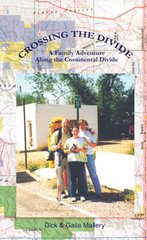
If you start or finish the CDT in Glacier there is no better place to explore! This is another piece of information you may enjoy.
Glacier National Park and its Canadian twin signify 2-nation cooperation
by Steve Yozwiak
GLACIER NATIONAL PARK, Mont. — In a time of war, I went in search of peace.With the conflict in Iraq the nation’s top political issue, I sought the 75th anniversary of a landmark event between Canada and the United States intended to show the world how neighboring countries can work in partnership to protect the environment and benefit citizens.In 1932, Alberta’s Waterton Lakes National Park and Montana’s Glacier National Park were proclaimed the world’s first International Peace Park. It’s a World Heritage Site. It’s an internationally recognized Biosphere Reserve. But in and around this place of peace, I could find no one who knew that the peace park was turning 75, let alone how this milestone might be celebrated.The man behind the bar in nearby Columbia Falls, Mont., didn’t know. The saleswoman at a local time-share development didn’t know. The clerk behind the convenience-store counter just outside the park’s west entrance didn’t know. The woman at the local camera shop didn’t know.Joyce Clarke Turvey, who for 30 years has tended her late father’s art gallery in East Glacier Park, didn’t know.Surrounded by animal still lifes of legendary wood carver John Louis Clarke, Turvey said she did know why the park should be celebrated.This place eclipses more popular, and crowded, mountain regions, such as Yellowstone National Park and even Europe’s Alps, she said."To me, the (northern) Rockies are more individual, more special," where each peak has its own character, Turvey said. "They change with the season, and they’re beautiful all times of the year."You can hike on a trail and be by yourself." (Turvey’s favorite hikes are near Logan Pass, at the Continental Divide, in the middle of the park.)Glacier is a many days’ drive from just about anywhere. You can fly into the small airport in nearby Kalispell, Mont., but it will cost you. If you have the time and the money, you can take Amtrak’s American Orient Express to the park. About a century ago, Great Northern Railway’s president, Louis Hill, built a series of lodges and backcountry outposts that today represent one of the nation’s largest collections of Swiss chalet-style architecture. In addition to stations in the park, trains stop at the historic Isaak Walton Inn in Essex, Mont., at the southern end of the park. The inn’s basement is a museum depicting train wrecks caused by floods, landslides and avalanches. Nearby tracks are sheltered for miles by wooden sheds.
Taking the scenic route
We opted to fly from Phoenix to Spokane, Wash., where we picked up a rental car and took a scenic five-hour drive through the panhandle of Idaho into northwestern Montana. Along the way, we stopped at the Mission Mountain Winery, Montana’s oldest winery, in Dayton.Pinot Noir grapes grow surprisingly well here, said Cheryl Tassemeyer, who has poured samples in the tasting room since the winery opened 23 years ago. "I love it. I just live right up here," Tassemeyer said, thumbing over her shoulder at a collection of homes on the western shore of Flathead Lake. In springtime Montana, huckleberries rule. You can buy huckleberry jams and jellies, huckleberry syrup, huckleberry honey. Roadside stands sell huckleberry smoothies. So it was no surprise when Tassemeyer whipped out a huckleberry wine. We took that one home.At Glacier, the experience is all about the water - frozen, snowing, raining, spraying, misting, flowing.Trapped in ice on jagged mountain peaks or seething through the surrounding forest, it is the water that you see, smell, hear, feel.A highlight is driving the Going-to-the-Sun Road, which bisects the park. A November blizzard wiped out the precarious roadway in two spots, but crews were expected to finish repairs and reopen the road as early as this week. Along the steep, undulating curves of this road you find access routes to the park’s remaining, and shrinking, glaciers.
Global-warming witness
The park has 26 named glaciers, down from 150 in 1850. In 1997, the U.S. Geological Survey predicted that by 2030, the park would have no glaciers. That likelihood has prompted one environmental group, the National Environmental Trust, to suggest renaming the park. Glacier is home to one of the USGS’s research projects on global climate change. Environmentalists point to the shrinking glaciers as evidence of global warming.So perhaps it is fitting that some of the world’s leading thinkers will convene Sept. 9-12 across the border in Waterton, Alberta, to celebrate the 75th anniversary of the world’s first peace park.
by Steve Yozwiak
GLACIER NATIONAL PARK, Mont. — In a time of war, I went in search of peace.With the conflict in Iraq the nation’s top political issue, I sought the 75th anniversary of a landmark event between Canada and the United States intended to show the world how neighboring countries can work in partnership to protect the environment and benefit citizens.In 1932, Alberta’s Waterton Lakes National Park and Montana’s Glacier National Park were proclaimed the world’s first International Peace Park. It’s a World Heritage Site. It’s an internationally recognized Biosphere Reserve. But in and around this place of peace, I could find no one who knew that the peace park was turning 75, let alone how this milestone might be celebrated.The man behind the bar in nearby Columbia Falls, Mont., didn’t know. The saleswoman at a local time-share development didn’t know. The clerk behind the convenience-store counter just outside the park’s west entrance didn’t know. The woman at the local camera shop didn’t know.Joyce Clarke Turvey, who for 30 years has tended her late father’s art gallery in East Glacier Park, didn’t know.Surrounded by animal still lifes of legendary wood carver John Louis Clarke, Turvey said she did know why the park should be celebrated.This place eclipses more popular, and crowded, mountain regions, such as Yellowstone National Park and even Europe’s Alps, she said."To me, the (northern) Rockies are more individual, more special," where each peak has its own character, Turvey said. "They change with the season, and they’re beautiful all times of the year."You can hike on a trail and be by yourself." (Turvey’s favorite hikes are near Logan Pass, at the Continental Divide, in the middle of the park.)Glacier is a many days’ drive from just about anywhere. You can fly into the small airport in nearby Kalispell, Mont., but it will cost you. If you have the time and the money, you can take Amtrak’s American Orient Express to the park. About a century ago, Great Northern Railway’s president, Louis Hill, built a series of lodges and backcountry outposts that today represent one of the nation’s largest collections of Swiss chalet-style architecture. In addition to stations in the park, trains stop at the historic Isaak Walton Inn in Essex, Mont., at the southern end of the park. The inn’s basement is a museum depicting train wrecks caused by floods, landslides and avalanches. Nearby tracks are sheltered for miles by wooden sheds.
Taking the scenic route
We opted to fly from Phoenix to Spokane, Wash., where we picked up a rental car and took a scenic five-hour drive through the panhandle of Idaho into northwestern Montana. Along the way, we stopped at the Mission Mountain Winery, Montana’s oldest winery, in Dayton.Pinot Noir grapes grow surprisingly well here, said Cheryl Tassemeyer, who has poured samples in the tasting room since the winery opened 23 years ago. "I love it. I just live right up here," Tassemeyer said, thumbing over her shoulder at a collection of homes on the western shore of Flathead Lake. In springtime Montana, huckleberries rule. You can buy huckleberry jams and jellies, huckleberry syrup, huckleberry honey. Roadside stands sell huckleberry smoothies. So it was no surprise when Tassemeyer whipped out a huckleberry wine. We took that one home.At Glacier, the experience is all about the water - frozen, snowing, raining, spraying, misting, flowing.Trapped in ice on jagged mountain peaks or seething through the surrounding forest, it is the water that you see, smell, hear, feel.A highlight is driving the Going-to-the-Sun Road, which bisects the park. A November blizzard wiped out the precarious roadway in two spots, but crews were expected to finish repairs and reopen the road as early as this week. Along the steep, undulating curves of this road you find access routes to the park’s remaining, and shrinking, glaciers.
Global-warming witness
The park has 26 named glaciers, down from 150 in 1850. In 1997, the U.S. Geological Survey predicted that by 2030, the park would have no glaciers. That likelihood has prompted one environmental group, the National Environmental Trust, to suggest renaming the park. Glacier is home to one of the USGS’s research projects on global climate change. Environmentalists point to the shrinking glaciers as evidence of global warming.So perhaps it is fitting that some of the world’s leading thinkers will convene Sept. 9-12 across the border in Waterton, Alberta, to celebrate the 75th anniversary of the world’s first peace park.












No comments:
Post a Comment